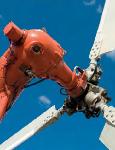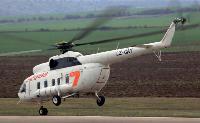Фотографии
-
The Russian Air Force still operates around 100 Mi-8T/Ps, and a significant proportion are used for training at Syzran.
Самолёты на фотографии: Миль Ми-8 / Ми-8Т - Россия - 1962
-
This Mi-8T is operated by the Flight Research Institute at Zhukovsky for search and rescue and various research initiatives.
Самолёты на фотографии: Миль Ми-8 / Ми-8Т - Россия - 1962
-
Регистрационный номер: RA-22769 Krasnodar-based PANH is among the largest operators of the Mi-8T in Russia, which uses the type for a wide variety of utility roles.
Самолёты на фотографии: Миль Ми-8 / Ми-8Т - Россия - 1962
-
Регистрационный номер: RA-24747 The Mi-8T is a real workhorse in the extreme cold of Russia’s far northern territories and Siberia.
Самолёты на фотографии: Миль Ми-8 / Ми-8Т - Россия - 1962
-
Регистрационный номер: RA-24213 PANH, which operates this Mi-8T, believes there is still plenty of life remaining in its Mi-8T fleet.
Самолёты на фотографии: Миль Ми-8 / Ми-8Т - Россия - 1962
-
Регистрационный номер: OM-XYC The Slovakian company Techmont uses Mi-8T/P OM-XYC for a range of specialist transport services, including moving pipes.
Самолёты на фотографии: Миль Ми-8 / Ми-8Т - Россия - 1962
-
The 1960s-era rotor blades on the Mi-8T/P are restricted to 3,000 hours or ten years’ service, making them a focus area in any future upgrade.
Самолёты на фотографии: Миль Ми-8 / Ми-8Т - Россия - 1962
-
Регистрационный номер: UR-MSF [2] Thirteen Mi-8MSBs have been ordered by Ukraine’s military and national guard for tactical transport.
Самолёты на фотографии: Миль Ми-8 / Ми-8Т - Россия - 1962
-
Регистрационный номер: RA-24100 More than 600 Mi-8T/Ps are in commercial use in Russia, with another 100 held in storage that could be re-introduced following refurbishment.
Самолёты на фотографии: Миль Ми-8 / Ми-8Т - Россия - 1962
-
Регистрационный номер: RA-24499 Most of the Mi-8T’s commercial operators in Russia, such as Karelia, are compelled to keep their old Mi-8Ts in service for as long as possible.
Самолёты на фотографии: Миль Ми-8 / Ми-8Т - Россия - 1962
-
Регистрационный номер: UR-MSF [2] The Mi-8MSB is a re-engined derivative of the basic Mi-8T offered by Motor Sich of Ukraine with increased hot-and-high performance, range and payload, but no avionics and instrumentation improvements.
Самолёты на фотографии: Миль Ми-8 / Ми-8Т - Россия - 1962
-
Регистрационный номер: LZ-CAY Only a handful of 'classic' Mi-8s are used by commercial operators in Europe. Most are operated by Heli Air of Bulgaria supporting UN humanitarian operations in Sudan and South Sudan.
Самолёты на фотографии: Миль Ми-8 / Ми-8Т - Россия - 1962
-
The Mi-8’s spacious stand-up cabin can accommodate up to 24 passenger seats or bulky cargo.
Самолёты на фотографии: Миль Ми-8 / Ми-8Т - Россия - 1962
-
The new derivatives of the Mi-8/Mi-17/Mi-171, such as this UTair Mi-8AMT, are more expensive than the Mi-8T/P in price and direct operating costs. Most, if not all, existing Mi-8T operators do not see them as direct replacements.
Самолёты на фотографии: Миль Ми-8МТВ-5 / Ми-17В-5 / Ми-8АМТ - Россия - 1995
Статьи
- -
- News
- A.Drwiega - Camcopter to the Rescue /Technology/
- A.Mladenov - Still Going Strong /Military/
- A.Mladenov - Workhorse Soldiers On /Commercial/
- A.Spaeth - The Last of its Kind /Commercial/
- D.Unwin - An Austrian Gem /Commercial/
- H.-P.Grolleau - 'Transallito' /Military/
- M.Broadbent - Improving the Flow /Technology/
- N.Pittaway - Introducing Growler /Military/
- P.Butowski - Katran & Helix /Military/
- P.Butowski - Russian Fighter Showcase /Military/
- R.Niccoli - Changing Times /Military/
- R.Niccoli - Turkey's F-16s /Military/
- R.Yanez, A.Rodriguez - Patas Negras /Military/
- S.Santana - Perfecting a Striker /Military/













